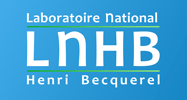LSC practical aspects
The following items describes practical aspects of LSC from different metrology labs.
PTB experience
Sample composition:
We use 15 ml Ultima Gold (bottle opened not more than 3 months before) and 0,5 or 1 ml of water to be sure on the concentration of water micelles, or, in case of elements only stable in a very acidic solutions (e.g. Pa-233, the daughter of Np-237), 15 ml of Ultima Gold AB with 1 ml of 6 m HCl.
As a quenching agent we use nitromethane and not CHCl3 or CCl4. The reason is the high Z of Cl.
Counting technique:
Open channel. In case of beta emitters with a high energy (e.g. P-32, Y-90, Sr-89) we found count rates which are too low. Therefore in such cases we use quenched samples.
It may be a specific effect of the Wallac 1414 counter. (Experience from anybody?)
Quality check:
We repeat the countings over a long time and look for changes in the results. Grau Carles had reported changes in the spectra, but we don’t use this for a check.
LSC vials
Using translucent vial surface improves detection efficiency and spectrum resolution.
Etching glass recipes
Etching the external surface of a glass vial improves LSC detection efficiency and LS-spectroscopy resolution.
Why?
Because with clear vials, at the interface between air and the external enveloppe of the vial, there is a refractive index step (1.5 to 1). This causes internal reflexion if the incidence angle of the photon, relative to the surface normal, is greater than a critical angle (about 42°). Two main consequences:
- less light can escape the vial, so the detection efficiency is decreased;
- all parts of the scintillator are not equivalent: light created in the middle of the vial can escape because its incidence is always normal to the surface. This is not the case for light emitted near the glass enveloppe. This causes an excess variance in the distribution of photons emitted by the vial and lower the energy resolution of the spectrum. This is specially evident for LS alpha spectroscopy.
This problem can easily be solved by etching the vial surface. At a microscopic level, the surface incidence is random and this increases the transmission probability.
How to etch glass surfaces?
– The quick and dirty method
Wrap a translucent adhesive tape around the vial. That’s it!
This works fine but can cause some mechanical problems in some LS-counters…
– The chemical method (courtesy Wallac Oy, 1998)
Grind in a mortar (not a glass mortar!) the following chemicals:
- 15 g of sodium fluoride
- 10 g of ammonium sulfate
- 15 g of barium sulfate
Add:
- 8 g of oxalic acid
- 12 g of water
- 40 g of glycerol
Soak the glass vials in the mixture and let them stay there for 2 to 4 days.
Wash the vials with plenty of water and dry.
The etching mixture can be stored in plastic bottle in refrigerator.
